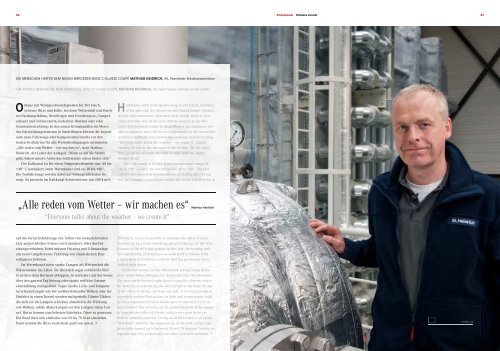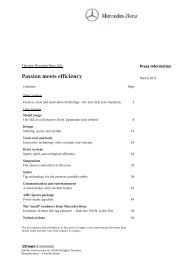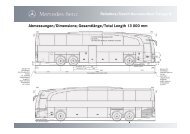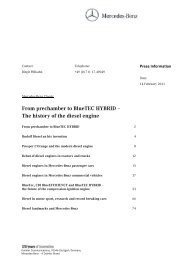Mercedes-Benz C-Klasse Coupé Magazin - Daimler
Mercedes-Benz C-Klasse Coupé Magazin - Daimler
Mercedes-Benz C-Klasse Coupé Magazin - Daimler
Sie wollen auch ein ePaper? Erhöhen Sie die Reichweite Ihrer Titel.
YUMPU macht aus Druck-PDFs automatisch weboptimierte ePaper, die Google liebt.
66<br />
Klimakanal Climate tunnel<br />
67<br />
DIe MenSCHen HInter DeM neuen MerCeDeS-BenZ C-KlaSSe CouPé matHias HeidricH, 45, teamleiter Windkanalzentrum<br />
tHe PeoPle BeHInD tHe neW MerCeDeS-BenZ C-ClaSS CouPé matHias HeidricH, 45, team leader climate tunnel centre<br />
orkane mit Windgeschwindigkeiten bis 265 km/h,<br />
extreme Hitze und Kälte, trockene Wüstenluft und feuchtes<br />
Dschungelklima, Nieselregen und Gewitterguss, Graupelschauer<br />
und Schneesturm, bedeckter Himmel oder volle<br />
Sonneneinstrahlung: In den neuen Klimakanälen im <strong>Mercedes</strong>-Entwicklungszentrum<br />
in Sindelfingen können die Ingenieure<br />
neue Fahrzeuge oder Komponenten bereits vor den<br />
realen Testfahrten für alle Wetterbedingungen optimieren.<br />
„Alle reden vom Wetter – wir machen es“, lacht Mathias<br />
Heidrich, der Leiter der Anlagen. „Wenn es auf die Straße<br />
geht, haben unsere Autos das Schlimmste schon hinter sich.“<br />
Der Kaltkanal ist für einen Temperaturbereich von -40 bis<br />
+40° C konzipiert, beim Warmkanal sind es -10 bis +60°.<br />
Die Testfahrzeuge werden dabei auf Rollenprüfständen bewegt.<br />
So prasseln im Kaltkanal Schneestürme mit 200 km/h<br />
Hurricanes with wind speeds of up to 265 km/h, extremes<br />
of hot and cold, dry desert air and humid jungle climates,<br />
drizzle and rainstorms, sleet and snow, cloudy skies or sunshine<br />
and blue sky: in the new climate tunnels at the <strong>Mercedes</strong><br />
Development Centre in Sindelfingen, the engineers are<br />
able to optimise new vehicles or components for all conceivable<br />
weather conditions, long before they undergo real-life testing.<br />
“Everyone talks about the weather – we create it”, laughs<br />
Mathias Heidrich, the manager of the facility. “By the time<br />
they go out on the road, our cars already have the worst<br />
behind them.”<br />
The cold tunnel is designed for a temperature range of<br />
-40 to +40° Celsius, the hot tunnel for -10 to +60°. The test<br />
vehicles are moved on dynamometers so that in the cold tunnel,<br />
for example, a snowstorm might fall on the test vehicles at<br />
„Alle reden vom Wetter – wir machen es“ mathias<br />
“Everyone talks about the weather – we create it”<br />
Heidrich<br />
auf die Versuchsfahrzeuge ein. Selbst von vorausfahrenden<br />
Lkw aufgewirbelter Schnee wird simuliert. Oder das Enteisungsverhalten:<br />
Dabei müssen Heizung und Klimaanlage<br />
ein zuvor tiefgefrorenes Fahrzeug von einem dicken Raureifpanzer<br />
befreien.<br />
Im Warmkanal holen starke Lampen als Weltneuheit die<br />
Wüstensonne ins Labor. Sie lässt sich sogar seitlich bis fünf<br />
Grad über dem Horizont abkippen. So wird der Lauf der Sonne<br />
über den ganzen Tag hinweg oder starke seitliche Sonneneinstrahlung<br />
nachgeahmt. Sogar rasche Licht- und Temperaturschwankungen<br />
wie bei vorüberziehenden Wolken oder der<br />
Einfahrt in einen Tunnel werden nachgestellt: Dünne Tücher,<br />
die sich vor die Lampen schieben, simulieren die Wirkung<br />
von Wolken, solide Abdeckungen vor den Lampen einen Tunnel.<br />
Hinzu kommt eine beheizte Fahrbahn. Diese so genannte<br />
Hot Road lässt sich stufenlos von 50 bis 70 Grad einstellen.<br />
Dann kommt die Hitze realistisch auch von unten. •<br />
200 km/h. It is even possible to simulate the effect of snow<br />
churned up by a truck travelling ahead of the car. Or the effectiveness<br />
of the de-icing system: in this test, the heating and<br />
air conditioning systems have to work hard to release from<br />
a thick layer of hoarfrost a vehicle that has previously been<br />
chilled right down.<br />
In the hot tunnel, on the other hand, strong lamps make<br />
their world debut, bringing the desert sun into the laboratory.<br />
The sun can be lowered right down to just five degrees above<br />
the horizon, so simulating the sun’s progress through the day<br />
or the effect of strong sun from one side. It is even possible to<br />
reproduce sudden fluctuations in light and temperature, such<br />
as those experienced when clouds pass overhead or a car enters<br />
a tunnel: fine screens can be pushed in front of the lamps<br />
to simulate the effect of clouds; solid covers over them are<br />
used to simulate a tunnel. On top of all this comes a so-called<br />
“Hot Road”, whereby the temperature of the road surface can<br />
be steadily heated up to between 50 and 70 degrees Celsius, so<br />
reproducing very realistically the effect of heat from below. •<br />
11C253_05







